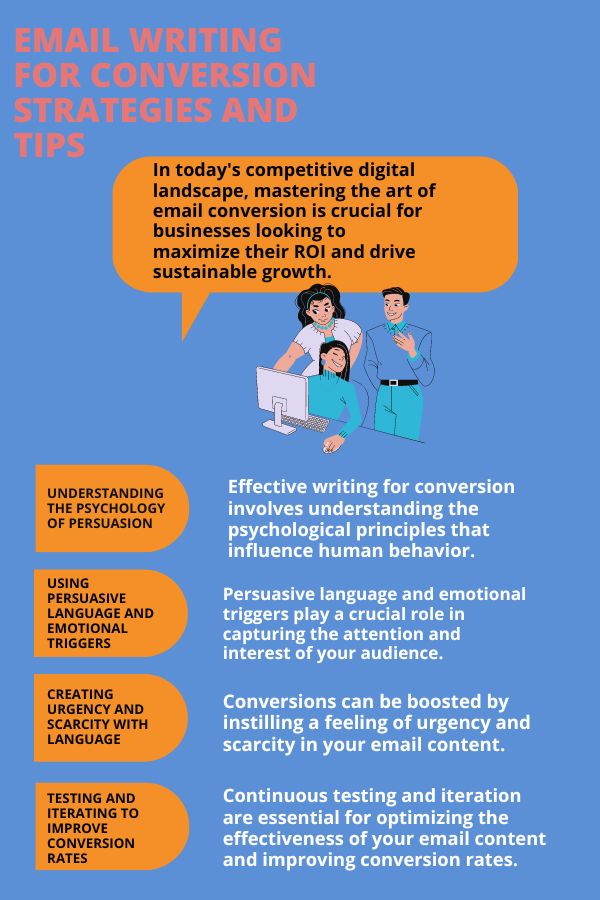Email remains a cornerstone of effective communication and marketing strategies in today’s digital landscape. Whether launching a new product, promoting a sale, or nurturing customer relationships, crafting engaging email content is essential for success. In this guide, we’ll explore the ins and outs of creating impactful email campaigns that resonate with your audience. From understanding the elements of a successful email campaign to mastering the art of crafting compelling content, we’ll provide the tools and strategies you need to elevate your email marketing efforts. So, let’s dive in and unlock the full potential of your marketing emails!
The Art of Effective Copywriting for Emails
In email marketing, effective copywriting plays a pivotal role in capturing your audience’s attention, sparking their interest, and ultimately driving them to take action. Let’s delve into each aspect of effective copywriting for emails:
Understanding Your Audience
Before you even begin crafting your email copy, it’s crucial to have a deep understanding of your audience. Take the time to research and analyze your target demographic, including their preferences, pain points, motivations, and communication style.
Crafting Attention-Grabbing Subject Lines
The subject line is the crucial element that appears on your recipients’ screens as soon as they get your email Component of your email copy. A compelling subject line should be concise, descriptive, and attention-grabbing. Use action-oriented language, urgency, and curiosity to attract the receiver’s attention and persuade them to open the email.
Writing Concise and Compelling Body Content
Once you’ve captured your audience’s attention with an enticing subject line, delivering value and maintaining their interest with concise and compelling body content is essential.
Incorporating Storytelling Techniques
Using stories to engage your audience and establish an emotional connection with them is an effective strategy. Incorporate storytelling techniques into your email copy by sharing relatable anecdotes, customer success stories, or case studies that illustrate the value of your product or service.
Leveraging Visual Elements for Enhanced Engagement:
In email marketing, visual components are essential, as they have the power to captivate recipients’ attention, convey information more effectively, and evoke emotions that drive engagement. Let’s explore each aspect of leveraging visual elements for enhanced engagement in email marketing:
Importance of Visual Appeal
Visual appeal is essential in email marketing because it can significantly impact recipients’ perception of your brand and their likelihood of engaging with your content.
Choosing the Right Images and Graphics
When selecting images and graphics for your emails, you must choose visuals that align with your brand identity, message, and audience preferences. High-quality, relevant, and visually appealing images can enhance your email’s overall look and feel and reinforce your brand’s personality and values.
Integrating Videos and GIFs Effectively
Videos and GIFs are dynamic visual elements that can add excitement and interactivity to your emails. Integrating videos allows you to showcase product demonstrations, customer testimonials, or behind-the-scenes footage, providing valuable content that engages and entertains recipients.
Ensuring Compatibility Across Devices and Email Clients
One of the most critical considerations when leveraging visual elements in email marketing is ensuring compatibility across various devices and email clients. Different devices and email clients may render emails differently, affecting how recipients perceive and interact with your visual content.
Optimizing Layout and Design for Readability
Optimizing the layout and design of your marketing email campaigns is crucial for ensuring readability and maximizing engagement with your audience.
Importance of Clean and Organized Layouts
Clean and organized layouts are essential for marketing emails as they enhance readability and make it easier for recipients to digest the content. A cluttered layout can overwhelm recipients and detract from the message you’re trying to convey.
Utilizing White Space Effectively
White or negative space refers to the empty space between design elements in your email. It is crucial in improving readability and visual appeal by providing breathing room and allowing content to stand out.
Creating Mobile-Responsive Designs
Nowadays, the majority of emails are seen on mobile devices. Designing your email campaigns with mobile responsiveness is essential. A mobile-responsive design ensures that your email content is optimized for viewing on various screen sizes and devices, providing a seamless experience for recipients regardless of their device preferences.
Testing and Refining Layout for Optimal Readability
Testing is a crucial step in optimizing the layout and design of your marketing emails for readability and effectiveness. Conduct A/B tests to compare layout variations and determine which design elements resonate best with your audience.
Utilizing Call-to-Actions’ Power (CTAs)
Harnessing the power of call-to-actions (CTAs) is essential for driving engagement and conversions in your marketing email campaigns.
Crafting Compelling CTAs that Drive Action
A compelling CTA is the driving force behind your email campaign’s success. Crafting CTAs that are clear, persuasive, and aligned with your campaign objectives is essential.
Placement Strategies for Maximum Effectiveness
The placement of your CTAs within your email content can significantly impact their effectiveness.
A/B Testing CTAs for Performance Optimization
A technique called A/B or split testing is a valuable strategy to maximize the effectiveness of your calls to action. Create multiple variations of your CTAs, testing elements such as wording, design, color, size, and placement to determine which combination resonates best with your audience.
Tracking and Analyzing CTA Performance Metrics
Tracking and analyzing CTA performance metrics is essential for assessing your email campaigns’ effectiveness and identifying areas for improvement. Use email marketing analytics tools to track metrics such as CTA clicks, conversions, revenue generated, and engagement levels.

Writing for Conversion: Strategies and Tips
Understanding the Psychology of Persuasion
Effective writing for conversion involves understanding the psychological principles that influence human behavior. Leveraging concepts such as social proof, authority, reciprocity, and scarcity can significantly impact the persuasiveness of your email content.
Using Persuasive Language and Emotional Triggers
Persuasive language and emotional triggers play a crucial role in capturing the attention and interest of your audience.
Creating Urgency and Scarcity with Language
Conversions can be boosted by instilling a feeling of urgency and scarcity in your email content. Use compelling language to convey time-sensitive offers, limited-time promotions, or exclusive deals that prompt recipients to act quickly.
Testing and Iterating to Improve Conversion Rates
Continuous testing and iteration are essential for optimizing the effectiveness of your email content and improving conversion rates. Conduct A/B tests to compare different variations of your email content, including subject lines, body copy, CTAs, and design elements.
By understanding the psychology of persuasion, using persuasive language and emotional triggers, creating urgency and scarcity with language, and testing and iterating to improve conversion rates, you can effectively write for conversion. Help make your email marketing operations more successful.
Conclusion
In conclusion, mastering the art of writing for conversion is essential for creating effective marketing email campaigns that drive results. Help make your email marketing operations more successful, persuasive language and emotional triggers, you can captivate your audience and compel them to take action. Creating urgency and scarcity with language adds a sense of immediacy and exclusivity to your offers, encouraging recipients to act quickly.
FAQ’s
How can one create engaging content?
What makes material compelling?
Compelling material is characterized by its ability to captivate and hold the audience’s attention. It resonates with them emotionally, intellectually, or creatively, making an impact that sticks and inspires people to act.
Which five Cs apply to content creation?
Which four principles support content writing?
What does it mean to write an engaging narrative?
Writing an engaging narrative involves crafting a story that resonates with your audience emotionally, intellectually, or personally. It should have compelling characters, a clear plot or message, and a sense of tension or conflict that keeps the audience invested. By creating relatable and immersive narratives, you can capture your audience’s imagination and leave a lasting impact.

